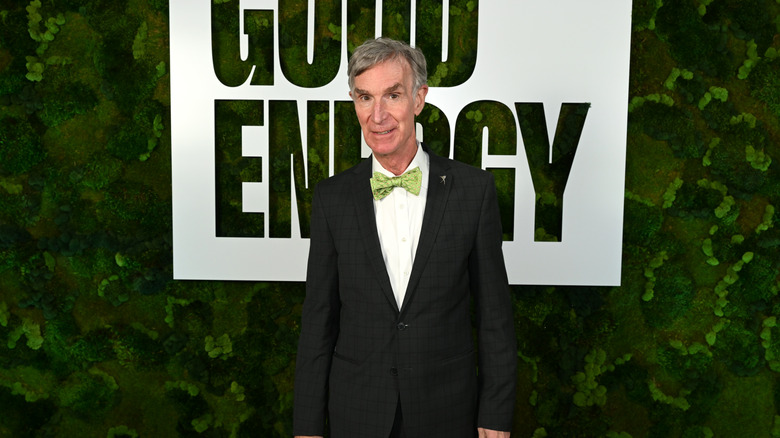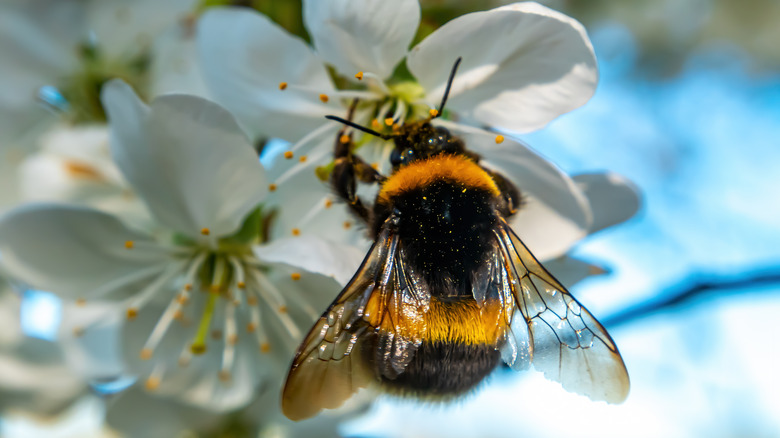Science Facts Bill Nye Has Gotten Wrong
Countless kids grew up tuning in to watch Bill Nye the Science Guy talk about things like physics, chemistry, and math and then perform some pretty spiffy experiments. That's great! Anything that gets kids interested in science is a good thing, after all ... and yes, there's a "but."
Nye has been doing his Science Guy thing for decades, and according to the National Post, there are plenty of people who think he's overstepping. Critics have cited his lack of scientific credentials — he's a mechanical engineer by trade — and condemned him for his perceived mockery of pseudoscientific beliefs in recent specials. Mocking beliefs rather than explaining the science they contradict doesn't get anyone anywhere, critics say.
In recent years, Nye has positioned himself as the face of America's scientific community. He's been on news shows arguing about the importance of climate change, he's been seen in viral videos alongside President Joe Biden, he's met with world leaders, and he's been appointed to things like the co-chair for the March for Science. But here's the thing: Not only did he start the Science Guy persona as part of his stand-up comedy routine, but he's not always right about the science he's delivering with an air of authority. Let's talk about the times that Bill Nye was wrong because sometimes, he's been wrong on a huge scale.
He's been called out for his stance on nuclear power
When Forbes science and energy writer James Conca wrote a piece lamenting the lack of accurate information put out by the media regarding nuclear power, he complained: "Actual nuclear scientists are never consulted by the media, only people like Bill Nye (whom I love, but has no expertise in nuclear)." Atomic Insights agreed, and when they fact-checked a keynote speech Nye gave at the Columbia University Coalition for Sustainable Development, they had numerous problems that started with fear-mongering.
That aside, Nye also said the U.S. military's interest in ships powered by nuclear energy was for the purpose of cutting down on their fuel usage, but that's not the entire truth. The driving factor — which was left out of his speech — was that nuclear power presented a controllable energy source that would free submarines from the need to vent waste gases into the atmosphere. The Atomic Insights post — written by atomic energy expert and former submarine engineer Rod Adams — also took issue with incorrect statements Nye made about the storage of nuclear waste (there are no reactor cores in Idaho, Adams clarifies), and at the end, suggested that Nye "break away from his tribe for a while to learn more about the use of nuclear energy."
Adams certainly isn't the only person to take issues with Nye's nuclear facts — the National Post reported that his claim that nuclear energy isn't a viable option for replacing fossil fuels runs contrary to what many scientists believe.
Sorry, that's not how bees work
It's one of those oft-repeated, so-called mysteries: Bumblebees, the story goes, are scientifically incapable of flight. First, let's explain where that came from. According to the International Business Times, it was a comment made jokingly in the 1930s by scientists studying the flight of fixed-wing aircraft. A bumblebee doesn't work in the same way as a plane, so it's kind of a moot point.
At any rate, Bill Nye was doing a Reddit session when he said that it was the question of how an ungainly-looking bumblebee could fly that inspired him to get into science in the first place. He claimed that he learned the answer later: "Their abdomens are springs, and their halteres" — small, flight-aiding structures behind the wings — "provide vortices which allow the wings to swing up with hardly any aerodynamic drag."
Sure, that sounds great, but entomologists have pointed out that it's not the least bit correct, starting with the fact that no bees — bumblebees included — have structures called halteres. Texas A&M University entomologist Juliana Rangel-Posada clarified that instead of the structures Nye talked about, bumblebees actually have two pairs of wings. And as for the mechanics of flight? Eric Mussen, a bee expert from the University of California, Davis, explained that bumblebees can rotate their wings in respect to the position of their bodies, and "the insects more or less 'row' their bodies through the air."
Arguments over Deflategate were just a mess
Remember the NFL scandal dubbed Deflategate? Here's a quick recap: The New England Patriots were accused of deflating some of their game balls, as QB Tom Brady liked the grip of a not-so-inflated ball better (via ESPN). Bill Nye chimed in amid the controversy, saying that coach Bill Belichick's science-based explanation for how the balls deflated themselves didn't make actual scientific sense, and went on to explain that the only way to change the pressure is with a gauge (per The Washington Post). Nye claimed that Belichick's explanation of what happened — that the outside temperature changed the ball's interior pressure — was wildly inaccurate.
Here's the thing, though: According to the American Physical Society, Nye himself was the one who was so, so wrong in saying that the inflation needle was the only way to change pressure. They confirm that, yes, the interior pressure of the ball could be changed by changing the properties of the ball itself (they suggest getting it wet and adding some stretch to the equation or changing the shape) or changing the temperatures of the gas inside or outside of the ball.
That's precisely the explanation Belichick gave, but there's a catch: Business Insider says that the temperature on the game day in question was nowhere near the extreme needed to change the pressure of the football. His science may have been more legit than Nye's, but it still wasn't good enough.
His comments on GMOs received pushback
When Bill Nye published a book and titled it "Undeniable," that sent a pretty clear message about the contents. There was one thing that had a huge section of the scientific community up in arms, though, and that was his condemnation of GMOs. He wrote (via Business Insider): "If you're asking me, we should stop introducing genes from one species into another. ... we just can't know what will happen to other species in that modified species' ecosystem."
That's when scientists came forward to tell Nye what they thought. University of Florida, Gainesville plant scientist Kevin Folta wrote an open letter to Nye in Discover, saying, "I am disheartened by your statements ... as they do not reflect the current state of our scientific understanding." To his credit, Nye actually met with one of the biggest companies in the GMO world, Monsanto. It not only convinced him to rewrite the chapter in his book, but during a sit-down with Bill Maher, Nye said: "I spent a lot of time with the scientists there, and I have revised my outlook."
The Washington Post says that Nye's change of heart was "proof he's the Science Guy." When he was shown more studies that backed up ideas about GMO crops being a way to sort of fast-track the kind of natural selection humankind has been doing for around 10,000 years, he was open to new knowledge. And that's science.
His new-found love of GMOs came with an 'oops'
Bill Nye's change of heart when it came to GMOs and the science of engineering crops made major headlines, and he spoke with HuffPost to explain just what new information he'd been given that made such a difference in his point of view. Among the points he made was the claim that GMOs "put the herbicides and pesticide inside the plant, rather than spraying it on them and having it run down into streams."
That, says Civil Eats, is inaccurate. They went on to explain that while yes, some GMO crops were made to manufacture their own insecticides, that wasn't the case with herbicides — many were being genetically modified to be able to withstand the deadly impact of herbicides like Roundup. Since these GMO crops can now be sprayed with herbicides containing glyphosate, that's actually led to an increase in the use of these chemicals, not a decrease. And that's by a lot: One study from Washington State University found that over a 16-year period, herbicide-resistant GMO crops led to the use of an extra 527 million pounds of herbicide. (In the same period, they led to a 123 million pound reduction in the use of pesticides.)
In a nutshell, agricultural practices are leaning heavily toward weed control via chemicals, whereas previous attempts at controlling weeds and other invasive plants were heavily environmental.
Quantum entanglement isn't his strong suit
Talking about quantum entanglement is mind-breakingly complicated, but let's give it a go — that's what we're here for.
In 2016, Bill Nye was asked how he thought quantum entanglement might change the world, and he suggested that if it was found to be real, it might allow for things like time travel and the harnessing of the energy in black holes. Forbes had all kinds of issues with this, starting with the fact that we already know quantum entanglement is real, and we've known that for a while. They went on to explain why numerous other comments he made were incorrect, adding that, yes, there are current and practical applications for using quantum entanglement (such as generating random number keys instantaneously for two people in different places), and no, it actually has nothing to do with leading to the possibility of time travel. If that sounds like a confusing turn of phrase, that's pretty much par for the course for this particular topic.
Chad Orzel, a Union College associate professor in the Department of Physics and Astronomy, adds that as far as the harnessing of black holes go, it's so completely wrong that it's hard to explain because there's no fundamental connection between quantum entanglement, black holes, and even the idea we can harvest them for energy — something which, he adds, he'd never ever heard of until Nye came up with it.
His philosophical missteps were too large to even summarize
In 2016, Bill Nye fielded a question about philosophy and, in doing so, made a lot of people very, very angry. In short, he was asked if philosophy was "meaningless," and he replied that yes, he thought it was.
Quartz penned a scathing condemnation of Nye's dismissal, saying that "his misconceptions are too large and many to show why each and every one is flawed." At the heart of the issue, though, were a few things: A belief that all areas of philosophy predominantly deal with the same questions, a belief that it involves making up some answers then going for a nap, and a belief that it's useless, circular logic. He also dismissed philosophy as having nothing to do with scientific fact, which had all kinds of people pointing out that both were built on critical thinking. Philosophical questions have done everything from shape public policy to ideas about what a society should be, and without the ability to reason, there would be no philosophy ... and no science, either.
About a year later, Quartz published a follow-up. Nye had read the original article, and it inspired him to do some reading and research into various philosophical fields. He read books, consulted with professors, and was shocked to learn that at one time, scientists had been called "natural philosophers." He admitted: "I've come late to this. Now I'm all about the philosophy. Bring it on."
Sure, it's just a Super Bowl commercial, but still ...
The number of people who tune in to the Super Bowl for the game and those who watch for the commercials are probably about the same, numerically speaking. The commercials are a big deal, and when Bill Nye teamed up to do one with the detergent Persil, Forbes wasn't shy about calling out the commercial's scientific mistakes — starting with the fact that the periodic table on the wall behind Nye was outdated by several missing elements. They also called him out for not using some of his lab equipment properly, and that was specifically the volumetric flasks. These flasks, they note, were filled to a seemingly random amount, but that's not what they're meant to do at all: They have a single line on them, and they're meant to be 100% accurate at measuring that one amount.
The final fact is one that should be first and foremost when it comes to science, and that's that safety is key. While Nye's lab coat is predictably crucial to the whole skit, he's also not wearing gloves when he's pouring chemicals, and he doesn't take some of the most basic safety procedures of using things like shields and fume hoods. As Forbes points out, sure, it's just a commercial, but it's just as easy to get these things right.
Misspeaking isn't the way to lend credence to climate change
One of Bill Nye's things is climate change, and he's done a lot when it comes to raising awareness. But when The Atlantic fact-checked his 2014 debate with Marsha Blackburn, then a member of the House of Representatives for Tennessee, they found that he made one comment that wasn't accurate. (It's worth noting that this was in comparison to Blackburn's comments, which were almost entirely inaccurate.)
Nye made a reference to the shrinking ice of Antarctica, and here's the thing: It seems to have just been a slip of the tongue. Because of the landmass that's beneath the ice of the Antarctic, the entire area is impacted by changing temperatures differently than the Arctic — which was depicted in the photo he held up and is what he was actually referring to. He was trying to get Blackburn to concede to the fact that sometime soon, it's projected that there's going to be no ice at the North Pole during the hemisphere's summer months. While misspeaking isn't uncommon, and everyone's had a slip or a hundred in their lifetime, a debate about climate change isn't the time for it to happen.
That time he became a spokesperson for Exxon wasn't great
At a time when at least some of the world is concerned about what's being done to the planet, videos of things like the Gulf of Mexico literally on fire due to leaks at an offshore drilling rig are pretty disturbing. It was alongside video of that fire that The Independent says something else started circulating, and that was an old video where Bill Nye and Ellen DeGeneres talked about the wonderful world of fossil fuels.
The bizarre video was actually done for a ride at Disney's Epcot Center, and anyone who thinks this might be the distant past would be wrong: it closed in 2017. The Exxon-sponsored ride sounds like it was plucked right out of the 1950s, and the video features Nye reassuring an uncertain DeGeneres that although we'd used up all the easy-to-reach oil, offshore drilling platforms were a perfectly safe way to reach fossil fuels that everyone depended on. Oh, and renewable energy just wasn't a viable way to keep the world running.
The Guardian has other problems with what's said, too: Nye suggests some fossil fuels are "clean-burning," when that's definitely not the case, and when DeGeneres asks about global warming, he says, "It's a hot topic with lots of questions, and it's one of the big reasons scientists are working on ways to burn fuels like coal more efficiently than ever."
Clean-burning coal? Not a thing.










